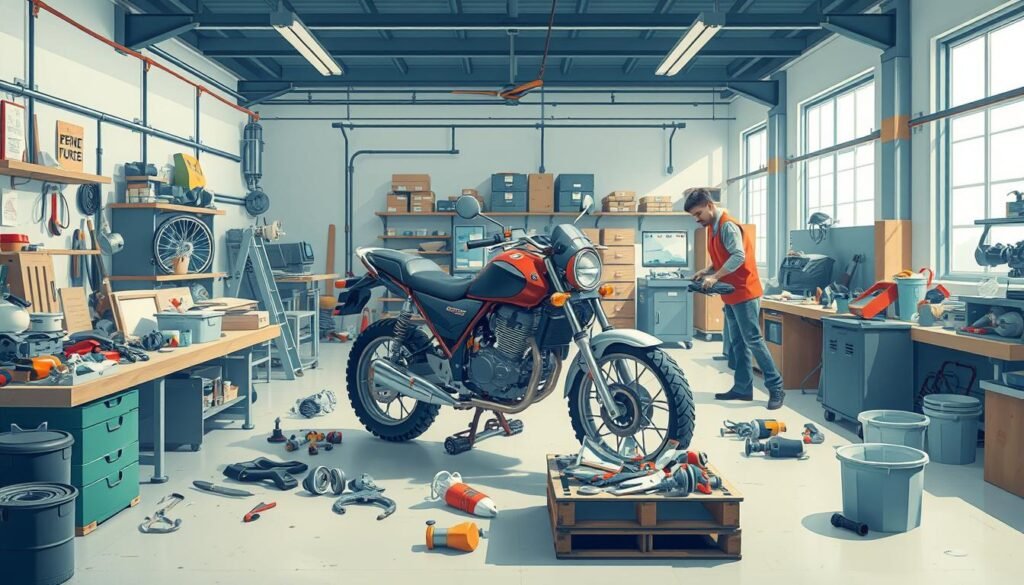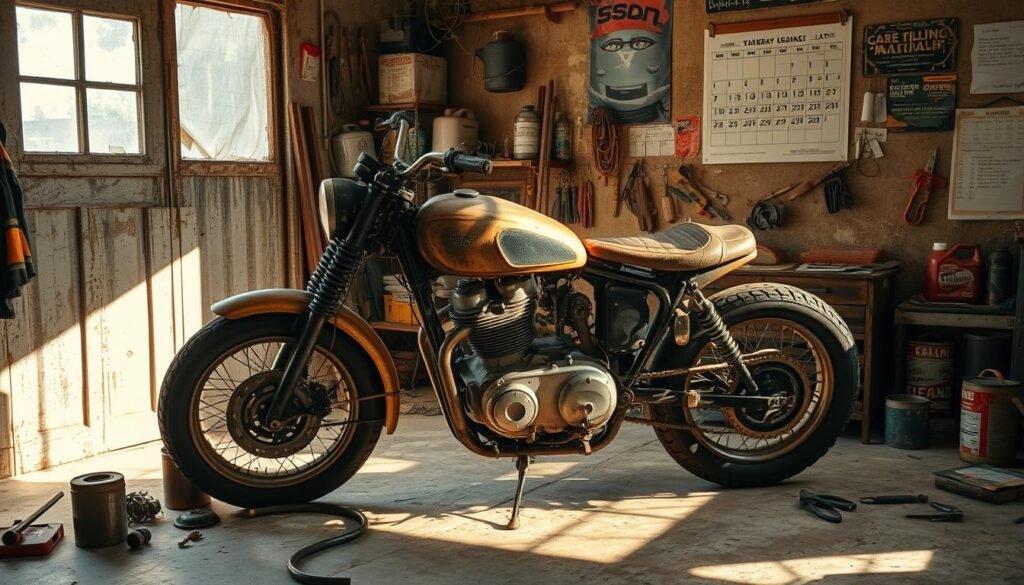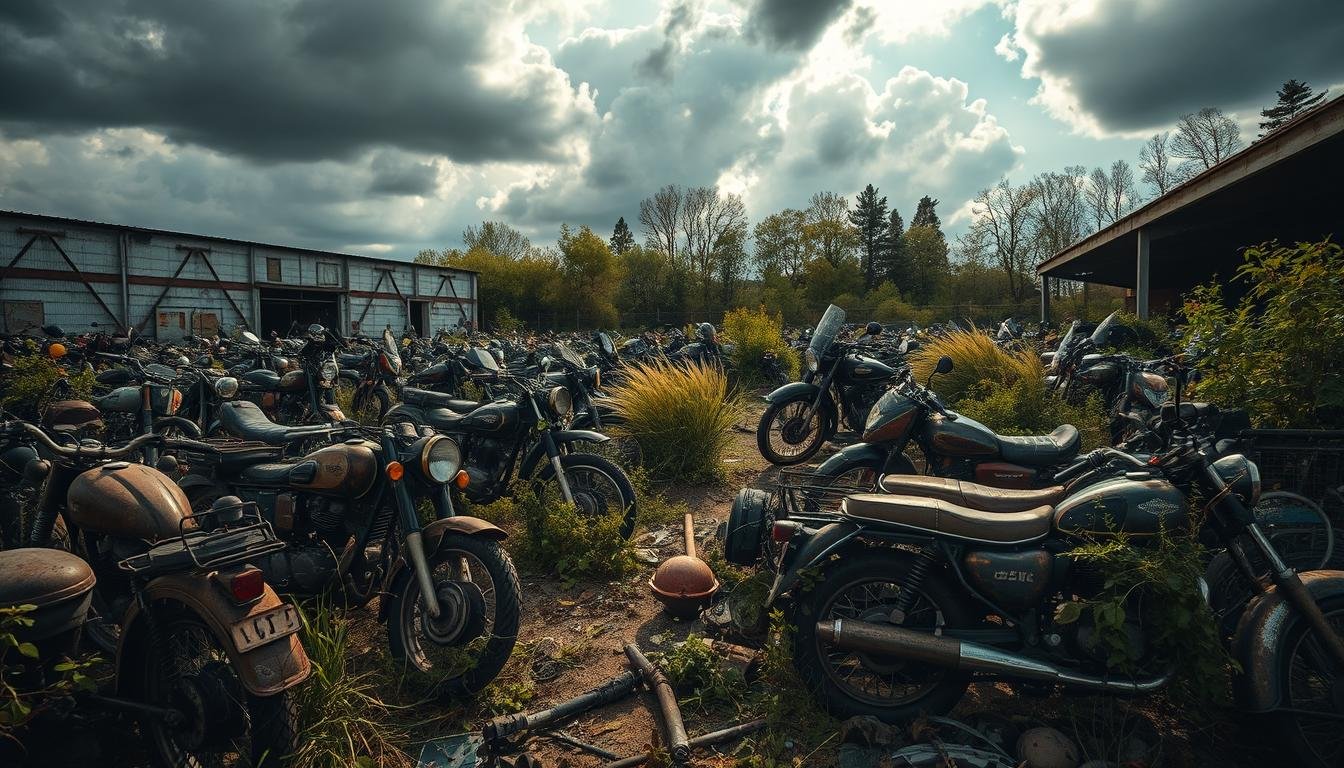Did you know Aussies scrap over 50,000 motorbikes each year? That’s a huge number of two-wheelers with untapped value. Your old bike, sitting in the garage, might be a goldmine waiting to be found through motorcycle salvage.
Whether it’s a vintage Triumph or a battered Yamaha, your old bike could be worth more than you think. The world of motorcycle recycling is growing fast. Savvy riders are making money from parts and materials that were once going to the tip.
Wrecking your old motorbike brings many benefits. It’s not just about getting rid of an old bike. It’s about finding hidden value and helping the environment for Aussie riders.
Key Takeaways
- Over 50,000 motorbikes are scrapped annually in Australia
- Old motorbikes can have significant hidden value
- Motorcycle salvage offers both financial and environmental benefits
- Vintage bikes may be very valuable in the wrecking market
- Recycling motorbikes helps make the automotive industry more sustainable
Understanding the Market for Old Motorbikes
The Australian market for old motorbikes is changing fast. If you want to sell your bike or find spare parts, knowing the trends is key.
Current Trends in Motorbike Sales
Old motorbike sales in Australia are on the rise. People are choosing pre-owned bikes for their value and unique appeal. This demand boosts the need for motorcycle spare parts, helping owners keep their bikes in top shape.
Factors Influencing Motorbike Values
Several things impact your old motorbike’s value:
- Age and model
- Condition and mileage
- Rarity of parts
- Brand reputation
Motorcycle wreckers look at these when deciding on parts. Knowing them can help you get the best price, whether selling the whole bike or parts.
The Rise of Vintage Motorbikes
Vintage motorbikes are becoming more popular in Australia. Collectors and fans are driving up prices for classic bikes. This trend opens new doors for bike owners and wreckers.
“The vintage motorbike market has grown by 30% in the past year alone, with rare models fetching premium prices.”
Keeping up with market changes helps you make better choices about your bike. You might sell, restore, or work with wreckers for parts.
Assessing Your Motorbike’s Condition
Before you decide to dismantle your motorcycle, it’s important to check its condition first. This check will help you decide whether to sell, restore, or wreck your bike. Let’s look at the main things to check and common problems that can lower your bike’s value.
Key Aspects to Evaluate
When checking your motorbike, pay attention to these important areas:
- Engine performance and compression
- Frame integrity and rust
- Electrical system functionality
- Tyre condition and tread depth
- Brake system efficiency
Checking these parts carefully will show you how your bike is doing. This info is key when thinking about dismantling or other choices.
Common Issues That Affect Value
Some problems can really hurt your bike’s value:
| Issue | Impact on Value |
|---|---|
| Engine knocking | High – may need a full rebuild |
| Frame damage | Severe – often means it’s a write-off |
| Electrical faults | Moderate – depends on how complex it is |
| Worn tyres | Low – easy to replace |
| Brake issues | Moderate – a safety worry |
Knowing about these issues helps you make a smart choice for your bike’s future. If fixing it costs too much, dismantling might be the best choice. This way, you can still get some value from the parts.
The Benefits of Wrecking Your Old Motorbike
Wrecking your old motorbike can surprise you with benefits. It’s good for your wallet and the planet.
Environmental Impact and Recycling
Recycling motorbikes is key to less waste and saving resources. Taking your old bike to a junkyard helps the environment. They save parts and recycle materials like metal and plastics.

In Australia, recycling one motorbike saves up to 300 kg of CO2. That’s like driving a car over 1,000 km. Recycling makes a big difference for our planet.
Financial Gains from Selling as Parts
Wrecking your motorbike can also save you money. Even if the bike can’t ride anymore, parts still have value. Engines, frames, and small parts like mirrors can sell well.
- Engine parts often sell for 30-50% of their new price
- Rare or vintage components can command premium prices
- Even damaged parts may be valuable for their materials
Selling parts can earn you more than selling the whole bike. A junkyard can help find buyers for valuable parts. This way, you make money and help the environment by reducing waste.
Identifying Rare Parts in Your Old Motorbike
Your old motorbike might be hiding treasures. Some motorcycle spare parts can fetch a pretty penny if you know what to look for. Let’s explore how to spot these gems and determine their value.
What Makes a Part Valuable?
Rarity often drives up the price of motorcycle spare parts. Limited production runs, discontinued models, or parts from iconic bikes can be worth a lot. Quality materials like titanium or carbon fibre also increase value. Vintage parts from classic motorcycles are highly sought after by collectors and restorers.
How to Research Part Values
To find out what your motorcycle spare parts are worth, start by checking online marketplaces. Look for similar parts and note their prices. Specialist forums can be goldmines of information. Don’t forget to factor in the condition of your parts when estimating value.
| Part Type | Value Factors | Potential Worth |
|---|---|---|
| Engine Components | Rarity, Brand, Condition | $100 – $5000+ |
| Vintage Fairings | Age, Model, Originality | $200 – $3000+ |
| Custom Exhausts | Brand, Material, Performance | $150 – $2000+ |
Remember, the Australian market for motorcycle spare parts can differ from global trends. Local demand and availability play big roles in determining value. Keep an eye out for parts from iconic Aussie bikes or those suited to our unique riding conditions.
Where to Sell Your Old Motorbike
Selling your old motorbike can be a great way to make some extra cash. There are several options available for Aussie riders looking to part ways with their beloved two-wheelers. Let’s explore the best places to sell your old motorbike, from online platforms to local stores and motorcycle wreckers.
Online Platforms for Sales
The internet has made selling old motorbikes easier than ever. Popular online marketplaces like Gumtree and Facebook Marketplace offer a wide reach, connecting you with potential buyers across Australia. These platforms are free to use and allow you to upload photos and detailed descriptions of your bike.
When creating your listing, be sure to include clear photos of your motorbike from multiple angles. Provide accurate details about its condition, mileage, and any recent repairs or upgrades. This transparency will help attract serious buyers and smooth the sale process.
Local Stores and Wreckers
If you prefer a more hands-on approach, consider selling your old motorbike to local stores or motorcycle wreckers. These businesses often specialise in purchasing used bikes for parts or restoration. Motorcycle salvage yards can be very interested in older models or bikes with rare parts.
To find reputable motorcycle wreckers in your area, ask for recommendations from fellow riders or check online reviews. When dealing with local businesses, you might get a quicker sale, but keep in mind that their offers may be lower than what you’d get from a private buyer.
| Selling Option | Pros | Cons |
|---|---|---|
| Online Platforms | Wide reach, potentially higher price | Longer selling process, dealing with inquiries |
| Local Stores | Quick sale, expert assessment | Potentially lower offers |
| Motorcycle Wreckers | Interest in older or damaged bikes | Focus on parts value rather than whole bike |
Whether you choose to sell online or to local motorcycle wreckers, research your bike’s value beforehand. This knowledge will help you negotiate a fair price and ensure you get the best deal for your old motorbike.
The Emotional Connection to Your Old Motorbike
Deciding to part with your old motorbike is hard. Many riders feel a strong bond with their bikes. This makes letting go a tough choice.
Memories and Experiences
Your motorbike is more than a vehicle; it’s a time machine. It takes you back to special moments. Think of the long rides, scenic routes, and adventures you’ve had.
These experiences create a deep emotional connection. It can feel like saying goodbye to a friend.

Understanding Its Sentimental Value
Sentimental value often beats market value for old motorbikes. Your bike might have been a gift, a project, or a symbol of achievement. Recognising this emotional investment is key when considering disposal.
| Emotional Factor | Impact on Disposal Decision |
|---|---|
| Years of ownership | Stronger attachment, harder to let go |
| Memorable trips | Increased sentimental value |
| Customisations | Higher emotional investment |
| Family history | Deep-rooted connection |
It’s important to balance emotions with practicality. While it’s natural to feel attached, remember that disposal can give your bike a new purpose. It can be recycled or sold for parts, continuing its journey in a new way.
Tips for Preparing Your Motorbike for Sale
Getting your old bike ready for sale can increase its value. A clean, well-presented motorbike grabs buyers’ attention and might get a higher price. Here are some essential steps to get your ride ready and the paperwork you’ll need.
Cleaning and Presentation
A shiny bike makes a big difference. Begin with a deep clean, then focus on these areas:
- Polish chrome parts till they shine
- Clean and oil the chain
- Wipe down the seat
- Buff out small scratches
- Inflate tyres to the right pressure
First impressions are crucial. A clean bike shows it’s been well cared for. This can influence potential buyers or motorcycle dismantling yards.
Documentation You Might Need
Having the right paperwork makes selling easier. Collect these documents:
| Document | Purpose |
|---|---|
| Registration papers | Proves ownership |
| Service history | Shows maintenance record |
| RWC (Roadworthy Certificate) | Required in some states for sale |
| Modification certificates | If bike has been altered |
Having these papers ready can speed up the sale or motorcycle dismantling process. It shows you’re organised and builds trust with potential buyers.
Understanding Wrecking Yards and Their Roles
Motorcycle scrapyards are key in the automotive world. They recycle, source parts, and dispose of old bikes responsibly. Let’s explore how these yards work and how to choose the right one for you.
How Wrecking Yards Operate
Motorcycle wreckers have a clear process to get the most from each bike:
- Intake: They check and record each bike that comes in.
- Dismantling: Experts take out parts that can be used.
- Inventory: Parts are cleaned, listed, and stored.
- Sales: Parts are sold to repair shops, hobbyists, and others.
- Recycling: Leftover materials are recycled properly.
Choosing the Right Wrecking Yard
When picking a motorcycle scrapyard, think about these points:
- Reputation: Look for good reviews and a strong reputation.
- Inventory: Make sure they have what you need for your bike.
- Pricing: Compare prices for buying or selling parts.
- Environmental practices: Check how they recycle and dispose of materials.
| Factor | Why It’s Important |
|---|---|
| Reputation | Guarantees reliable service and fair deals. |
| Inventory | Boosts your chances of finding the parts you need. |
| Pricing | Helps you find the best value for your money. |
| Environmental practices | Supports green motorcycle recycling. |
Knowing how motorcycle wreckers work and what to look for helps you make smart choices. It lets you get the best deal and support green practices in the motorcycle world.
The Importance of Timing When Selling
Selling your old motorbike can be tricky. The right timing can make a big difference in how much you get for it. This is true whether you’re selling it whole or for motorcycle salvage.

Knowing When to Sell
The best time to sell your motorbike is when demand is high. In Australia, this often means spring and early summer. People are keen to hit the road when the weather warms up.
If you have a dirt bike, selling in autumn might be better. That’s when off-road enthusiasts are gearing up for the cooler months.
Seasonal Demand Trends
Demand for motorbikes and parts changes with the seasons. Here’s a quick guide:
- Spring/Summer: High demand for road bikes
- Autumn: Increased interest in off-road bikes
- Winter: Lower overall demand, but good for motorcycle salvage
Keep an eye on local events too. Bike shows or races can spark interest in certain models. This could boost your chances of a good sale. Remember, timing isn’t just about seasons. It’s also about the condition of your bike and the current market.
A well-maintained bike can sell at any time of year.
“The right time to sell is when you’re ready and the market is right.”
If you’re considering motorcycle salvage, winter can be a good time. Many riders use this season to fix up their bikes. They’re often looking for cheap parts. Your old bike could be just what they need.
Legal Considerations for Selling Old Motorbikes
When you’re ready to get rid of your old bike, knowing the legal stuff is key. In Australia, selling or wrecking a motorbike means you must pay attention to paperwork and registration rules.
Ownership Documentation
First, collect all the papers you need to prove you own the bike. This includes the title, proof of purchase, and service history. These documents show you’re the legal owner and can sell the bike.
Transfer of Registration
Transferring the bike’s registration is a big step. You need to go to your local transport office to do this. Here’s what you’ll need to do:
- Fill out a transfer form
- Pay any outstanding fees
- Provide the buyer’s details
- Submit a roadworthy certificate (if required in your state)
It’s your job to tell the transport authority about the sale. If you don’t, you might face problems later.
By following these steps, you make selling your bike easy and worry-free. It helps you and the buyer, making sure everyone is happy.
Negotiating the Best Price for Your Old Motorbike
Selling your old motorbike can be tricky, but you can get a fair price with the right approach. Let’s look at some effective strategies to help you negotiate and understand what buyers want.
Strategies for Effective Negotiation
When selling your old bike, knowing your stuff is key. Research the current market value of your motorbike and its spare parts. This info will help you start negotiations strong.
- Set a realistic price range
- Be prepared to explain your bike’s unique features
- Highlight any recent repairs or upgrades
- Stay calm and confident during negotiations
What to Expect from Buyers
Buyers vary, from enthusiasts to wrecking yards looking for parts. Each has different priorities and negotiation styles.
Individual buyers might care more about the bike’s condition and riding experience. Wrecking yards will focus on the value of individual parts. Be prepared to adjust your approach based on the buyer’s perspective.
“Remember, a fair deal leaves both parties satisfied. Don’t be afraid to walk away if the offer doesn’t meet your expectations.”
By understanding the market and your buyer’s needs, you’ll be in a strong position to negotiate the best price for your old motorbike or its valuable spare parts.
Exploring Alternatives to Wrecking
Before you send your old motorbike to the scrapyard, think about other options. These could give your bike a new life. Let’s look at ways to keep your bike on the road or give it a new form.
Restoring Your Old Motorbike
Restoring a motorcycle can be very rewarding. It takes patience and skill to make your bike look new again. First, check the bike’s condition and find parts.
Many classic models have communities that help with restoration. They offer advice and support.
Upcycling and Customisation Ideas
If you can’t restore your bike fully, think about upcycling. You can turn old parts into something new, like a wall clock or a lamp. This gives your bike a new purpose and helps with recycling.
Customisation is also exciting. You can change your cruiser into a cafe racer or a bobber. Australia has a growing custom motorcycle scene. Workshops and events showcase these unique bikes.
“Every old bike has potential. It’s up to you to unlock it, whether through restoration, customisation, or creative recycling.”
Choosing these alternatives saves your bike from the scrapyard. It also lets you preserve its history and show your creativity. Plus, it helps with sustainable motorcycle recycling in Australia.
The Future of Old Motorbikes in Australia
The Australian motorcycle market is changing, with old bikes leading the way. Let’s look into the future and see what’s in store for vintage motorcycles here.
Predictions for Market Trends
There’s a big increase in demand for classic bikes. Aussies love the charm of old machines. This has made old motorcycles very sought after, driving up their prices.
Motorcycle junkyards are now treasure hunts for rare parts. Enthusiasts are eager to find these gems.
Electric conversions of vintage bikes are becoming popular. This mix of old style and new tech is exciting. It’s giving new life to bikes that might have been scrapped.
Sustainability in Motorbike Ownership
There’s a growing focus on being green in the motorbike world. Owners want to keep their bikes running longer and reduce waste. This change is reshaping how we think about getting rid of old bikes.
Upcycling is all the rage. Old bike parts are being turned into furniture, art, and even fashion. It’s a creative way to reuse these mechanical wonders and reduce waste.
| Trend | Impact on Old Motorbikes |
|---|---|
| Rising Vintage Demand | Increased value, fewer bikes in junkyards |
| Electric Conversions | Extended life for classic frames |
| Upcycling | Creative reuse of parts, reduced waste |
The future is bright for old motorbikes in Australia. With more people appreciating them and new ways to be sustainable, these classic rides are far from done.
Conclusion: Unlocking the Hidden Value of Your Old Motorbike
Your old motorbike might be worth more than you think. We’ve looked at motorcycle wrecking and salvage in Australia. This includes market trends and how to check your bike’s condition.
Recap of Key Points
Wrecking has benefits like helping the environment and making money. Rare parts can be very valuable. Knowing where to sell is key. It’s also okay to feel attached to your bike.
Encouragement to Take Action
Now, take a close look at your old motorbike. Is it just sitting in your garage? It might be time to call some motorcycle wreckers. Or maybe you want to fix it up?
Whatever you decide, make an informed choice. Your old bike could bring in extra cash or be a fun project. You have the power to find out its true value.

